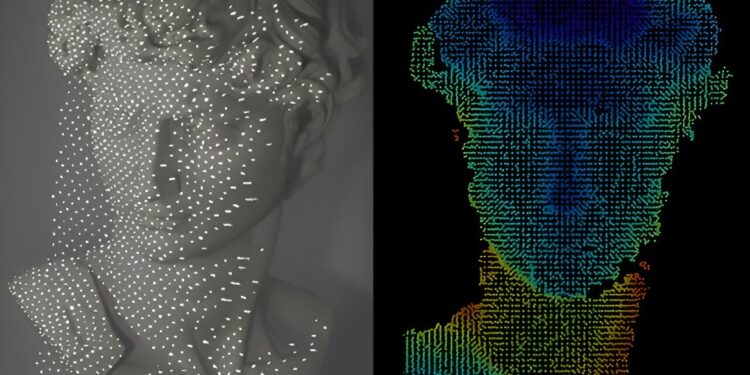A new compact, lensless facial recognition system scans a bust of Michelangelo’s David and reconstructs the image using less energy than existing 3D surface imaging systems. Credit: Nano letters (2024). DOI: 10.1021/acs.nanolett.3c05002
Many people are familiar with facial recognition systems that unlock smartphones and gaming systems or provide access to our online banking accounts. But current technology may require square-shaped projectors and lenses. Today, researchers report in Nano letters a sleeker 3D surface imaging system with flatter, simplified optics. In proof-of-concept demonstrations, the new system recognized the face of Michelangelo’s David as well as an existing smartphone system.
3D surface imaging is a commonly used tool in smartphone facial recognition, as well as computer vision and autonomous driving. These systems generally consist of a dot projector containing several components: a laser, lenses, a light guide and a diffractive optical element (DOE).
The DOE is a special type of lens that splits the laser beam into a set of approximately 32,000 infrared points. So when a person looks at a locked screen, the facial recognition system projects a set of dots across most of their face and the device’s camera reads the created pattern to confirm the identity. However, dot projector systems are relatively large for small devices such as smartphones. So, Yu-Heng Hong, Hao-Chung Kuo, Yao-Wei Huang and their colleagues decided to develop a facial recognition system that is more compact, almost flat and requires less energy to operate.
To do this, the researchers replaced a traditional dot projector with a low-power laser and a flat gallium arsenide surface, significantly reducing the size and power consumption of the imaging device. They etched the top of this thin metal surface with a nanopillar pattern, which creates a metasurface that scatters light as it passes through the material.
In this prototype, low-power laser light is dispersed into 45,700 infrared points which are projected onto an object or face placed in front of the light source. Like the dot projector system, the new system incorporates a camera to read the patterns created by the infrared dots.
During testing of the prototype, the system accurately identified a 3D replica of Michelangelo’s David by comparing infrared dot patterns to online photos of the famous statue. Notably, it achieved this using five to ten times less energy and on a platform with an area approximately 230 times smaller than a typical dot projector system. The researchers say their prototype demonstrates the utility of metasurfaces for efficient, small-scale, low-power imaging solutions for facial recognition, robotics and extended reality.
More information:
Wen-Cheng Hsu et al, Structured Light Based on Metasurface and PCSEL for Monocular Depth Perception and Face Recognition, Nano letters (2024). DOI: 10.1021/acs.nanolett.3c05002
Provided by the American Chemical Society
Quote: More elegant facial recognition technology tested on Michelangelo’s David (February 2, 2024) retrieved February 2, 2024 from
This document is subject to copyright. Except for fair use for private study or research purposes, no part may be reproduced without written permission. The content is provided for information only.



